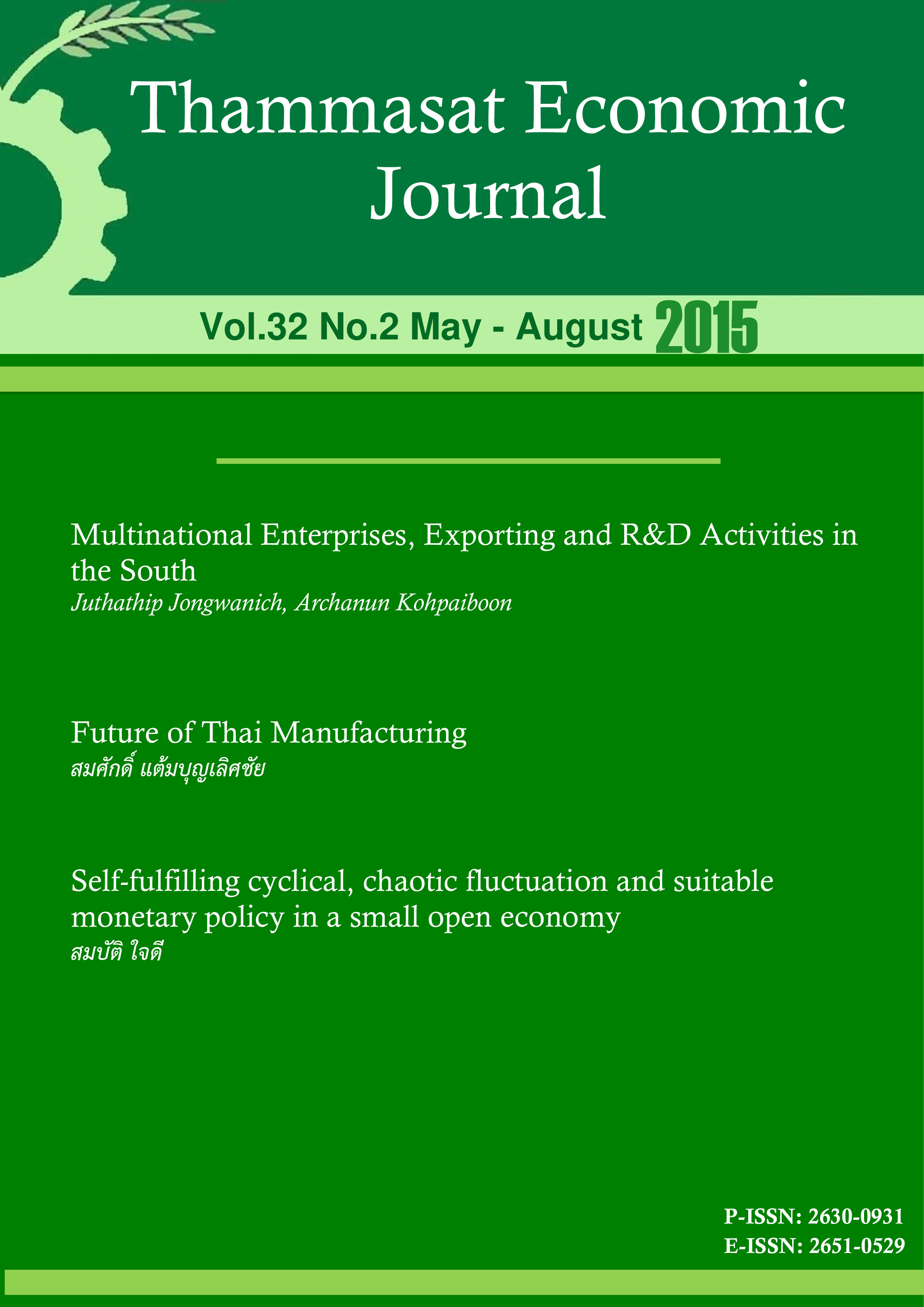Self-fulfilling cyclical, chaotic fluctuation and suitable monetary policy in a small open economy
Keywords:
Monetary Policy, Central Bank, Chaotic TheoryAbstract
This paper aims to identify risks of central bank, which could arise from an existence of endogenous cyclical and chaotic dynamics in small open economy. Dynamic stochastic general equilibrium (DSGE) is applied with Chaos theory. Our results show that at least two factors are verified as the source of economic instability at steady state, namely, degree of trade openness and degree of exchange rate pass-through. They jointly aggravate an intensity of expected future inflation which Central Bank could not be able to control well through changes in policy rate. In order to lessen or eliminate the chaos effect, Central Bank should decrease the degree of activism when the degree of trade openness is relatively high or to lower degree of exchange rate pass-through. However, it should be noted that very low degree of pass-through causes the household agents respond to an expected inflation which is not coherent to an actual exchange rate. As a result, the policy can induce a liquidity trap.
References
2. Airaudo M., & L. Zanna. (2012). Interest Rate Rules, Endogenous Cycles and Chaotic Dynamics in Open Economies, IMF Working Paper, 12/121.
3. Benhabib, J. and K. Nishimura (1979). The Hopf Bifurcation and The Existence and Stability of Closed Orbits in Multisector Models of Optimal Economic Growth, Journal of Economic Theory 21,421-444
4. Benhabib, J., Schmitt-Grohe, S., & Uribe, M. (2000). Monetary Policy and Multiple Equilibria, C. V. Starr Center Working Paper No. 98-02.
5. Benhabib, J., Schmitt-Grohe, S., & Uribe, M. (2001). Monetary Policy Rules and Multiple Equilibria. Economic Review, (91), 167-184.
6. Benhabib, J., Schmitt-Grohe, S., & Uribe, M. (2002). Chaotic Interest Rate Rules. American Economic Review, 92, 72-78.
7. Bernanke, B., T. Laubach, F. Mishkin (1999). Inflation Targeting, Princeton: Princeton University Press.
8. Bharucha, N., & Kent, C. (1998). Inflation Targeting in a Small Open Economy. Reserve Bank of Australia Discussion Paper No. 9807.
9. Blanchard, O. J., & Kahn, C. (1980). The Solution of Linear Deference Models under Rational Expectations, Econometric Society, 48(5), 1305-1311.
10. Calvo, G., & Reinhart, C. (2001). Fixing for Your Life, University Library of Munich, Germany 138-173.
11. Campa, M. & Goldberg, S. (2005). Exchange Rate Pass-through into Import Prices. Review of Economics and Statistics, 87(4), 679-690.
12. Chen, N., Imbs, J., & Scott, A. (2004). Competition, Globalization and the Decline of Inflation. Centre for Economic Policy Research Discussion Paper, 4695.
13. Gagnon, Joseph, E., & Ihrig, J. (2004). Monetary Policy and Exchange Rate Pass-Through. Board of Governors of the Federal Reserve System International Finance Discussion Papers 704 (revised version).
14. Hsieh, D. (1991). Chaos and Nonlinear Dynamics: Application to Financial Markets. Journal of Finance, 46(5), 1839-1877.
15. Ho, C., & Mac, R. (2003). Living with Flexible Exchange Rates: Issues and Recent Experience in Inflation Targeting Emerging Market Economies:, Working Paper 130.
16. King, R., & Wolman, A. (1996). Inflation Targeting in a St. Louis Model of the 21st Century. NBER Working Papers 5507, National Bureau of Economic Research, Inc.
17. Kydland, F., & Prescott, C. (1982). Time to Build and Aggregate Fluctuations. Econometrica, 50, 1345-1370.
18. Jihene, B. (2010). Degree of Openness and Inflation Targeting Policy: Model of a Small Open Economy. Internation Network for Economic Research – Working Paper 2010.2
19.Leiderman, L., & Svensson, L. (1995). Inflation Targets, London: Centre for Economic Policy Research.
20. Leitemo, K. (2004). Targeting Inflation by Forecast Feedback Rules in Small Open Economies. Manuscript, Norwegian School of Management BI.
21. Leitemo, K. (2006). Open-Economy Inflation Forecast Targeting. Forthcoming, German Economic Review.
22. McCallum, B., & Nelson, E. (1999). Nominal income targeting in an Open-Economy optimizing Model. Journal of Monetary Economics, 43(3), 553-578.
23. Mirowski P. (1989). The Rise and Fall of the Equilibrium Concept in Economic Theory. Recherches Economiques de Louvain, 1989, 4, 447-68.
24. Mirowski P. (1990). From Mandelbrot to Chaos in Economic Theory. Southern Economic Journal, 57:2 (October 1990), 289-307
25. Roisland O., Leitemo K., & Torvik R. (2004). Should Inflation-Targeting Central Banks care about Traded and Non-Traded Sectors?, The IUP Journal of Bank Management. 01/2006, V(1), 53-63.
26. Schmitt-Grohe, S. & M. Uribe (2000). Endogenous Business Cycles and the Dynamics of Output, Hours, and Consumption, American Economic Review 90 (December 2000), 1136-59.
27. Svensson, L. (1999). Inflation Targeting as a Monetary Policy rule. Journal of Monetary Economics, 43, 607-654.
28. Taylor, B. (2000). Low Inflation, Pass-Through, and the Pricing Power of Firms. European Economic Review, 44(7), 1389-1408.
29. สมบัติ ใจดี. (2556). ความผันผวนภายในระบบเศรษฐกิจเปิดขนาดเล็ก และนโยบายการเงินที่เหมาะสมภายใต้ทฤษฎีเคออส. วิทยานิพนธ์ปริญญามหาบัณฑิต. มหาวิทยาลัยธรรมศาสตร์, คณะเศรษฐศาสตร์.










